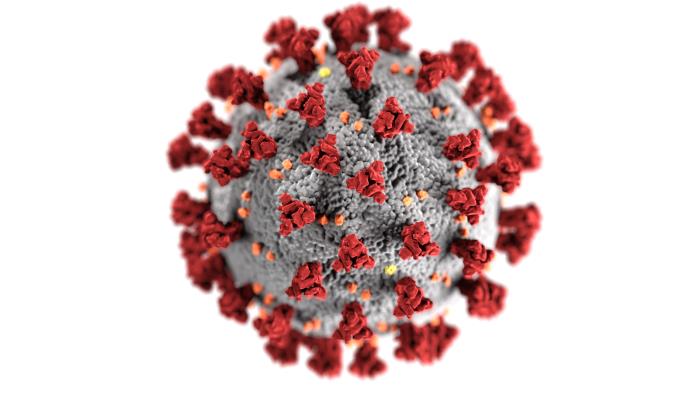(Apr 2020) You probably heard the terms coronavirus and COVID-19 in news reports and from friends and family, but what do they mean and are they the same. Can I use the words interchangeably? The answer is no! Let’s break all of this down.
The current pandemic we are experiencing is caused by SARS-CoV-2, a type of coronavirus. Coronavirus is a category of viruses known for their crown-like appearance when seen under an electron microscope. Corona is Spanish for crown which gives this family of viruses their name.

There are actually many types of coronaviruses and some of which cause what we call the common cold. The specific coronavirus that is causing this health crisis is SARS-CoV-2, which is genetically related to the virus responsible for the SARS outbreak in 2003.
Where does COVID-19 come into all of this? COVID-19 is the specific disease that SARS-CoV-2 causes with symptoms including fever, persistent dry cough and severe body aches. CO stands for corona while VI means virus. The 19 represents the fact that the SARS-CoV-2 virus and the disease it causes was first discovered in late 2019.
Now that you know the difference in what these terms mean, feel empowered to stop the spread of SARS-CoV-2! Practice social distancing and wash your hands frequently for at least 20 seconds. We can all do our part to stop cases of COVID-19!
Here are some other terms you may see in the coming weeks:
SARS-CoV-2: Severe acute respiratory syndrome coronavirus 2 was named by the International Committee on Taxonomy of Viruses (ICTV) on February 11th, 2020. The name of the virus was chosen because the virus is genetically related to the coronavirus responsible for the severe acute respiratory syndrome (SARS) outbreak of 20031.
COVID-19: The disease caused by SARS-CoV-2. The World Health Organization (WHO) on February 11th, 2020, announced the name1.
Pandemic: A global outbreak of a disease. Pandemics happen when a new virus emerges to infect and spread between people. On March 11th, 2020, the WHO characterized the COVID-19 outbreak as a pandemic2.
Social distancing: Social distancing, which is also called physical distancing, means to keep space between yourself and other people. To practice social distancing, it is recommended to: stay at least 6 feet (2 meters) from other people, do not gather in large groups (usually more than 10), and to stay away from crowded places and to avoid mass gatherings3.
Quarantine: To keep someone who might have been exposed to COVID-19 disease away from others. Someone in self-quarantine stays separated from others and limits movement outside of his or her home3.
Isolation: To separate sick people from healthy people. For example, people who are sick at home can isolate themselves from others by staying in a specific room and using a different bathroom if possible3.
Flattening the curve: The “curve” refers to the projected number of people who will contract COVID-19 over a certain period of time. The curve can take many different shapes depending on the infection rate of a particular virus. However, the idea is to reduce or “flatten the curve” in order prevent overwhelming of a healthcare system4.
Coronavirus: Coronaviruses are medium-sized enveloped positive stranded RNA viruses whose name derives from their characteristic crown-like appearance in electron micrographs. They are widespread among birds and mammals, with bats being a host to the largest variety of genotypes. Previously, there were 6 coronaviruses serotypes that have been associated with disease in humans: HCoV-229E, HCoV-NL63, HCoV-OC43, HCoV-HKU1, SARS, and the Middle East respiratory syndrome (MERS). Coronaviruses can cause respiratory tract infections, and certain coronaviruses can cause diarrhea in infants and children5.
Wuhan: A city in the Hubei province of China where a cluster of pneumonia cases were first identified at the end of 2019 resulting in the coronavirus disease known as COVID-196.
PPE: PPE stands for personal protective equipment, which are used everyday by healthcare personnel to protect themselves, patients, and others when providing care. PPE can include eye protection, gowns, N95 respirators, surgical masks, and gloves7.
References:
- https://www.who.int/emergencies/diseases/novel-coronavirus-2019/technical-guidance/naming-the-coronavirus-disease-(covid-2019)-and-the-virus-that-causes-it
- https://www.cdc.gov/coronavirus/2019-ncov/cases-updates/summary.html
- https://www.cdc.gov/coronavirus/2019-ncov/prevent-getting-sick/social-distancing.html
- https://www.livescience.com/coronavirus-flatten-the-curve.html
- https://www.uptodate.com/contents/coronaviruses?sectionName=Viral%20serotypes&search=coronavirus&topicRef=126981&anchor=H4&source=see_link#H1
- https://www.uptodate.com/contents/coronavirus-disease-2019-covid-19-considerations-in-children?search=covid19&source=search_result&selectedTitle=2~150&usage_type=default&display_rank=2
- https://www.cdc.gov/coronavirus/2019-ncov/hcp/ppe-strategy/index.html

